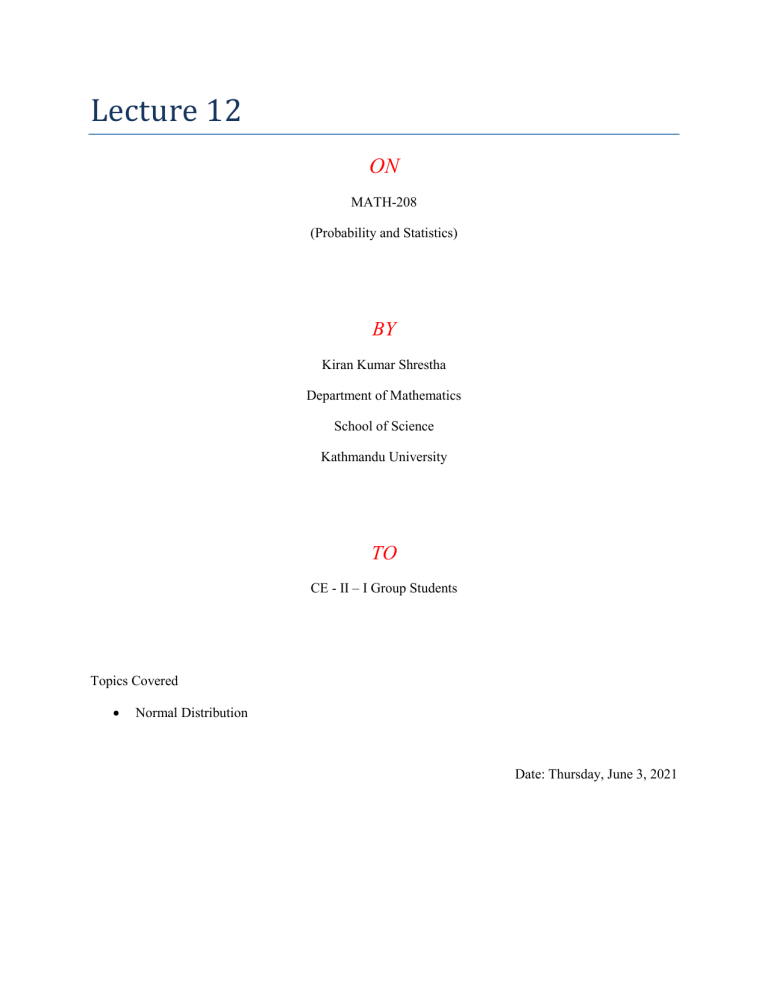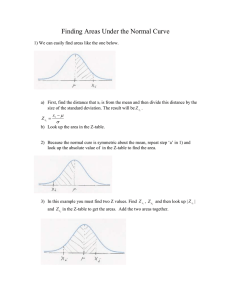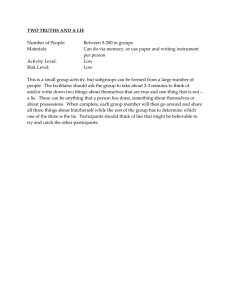
Lecture 12
ON
MATH-208
(Probability and Statistics)
BY
Kiran Kumar Shrestha
Department of Mathematics
School of Science
Kathmandu University
TO
CE - II – I Group Students
Topics Covered
Normal Distribution
Date: Thursday, June 3, 2021
Normal Distribution
(Notes Continued...)
#.9
Probability properties
If
(
), then
(
)
(
)
(
)
For a normal distribution 68.26% of data lie between the points of inflection, i.e.,
In the same way, 99.73% of data lie between
0.0027 lie outside
.
and only 100%-99.73% = 0.27% =
Example, If X ~ N(24, 32) , then
(a) (
)
(
)
(
)
(b) (
)
(
)
(c) (
)
(
)
#.10
The kurtosis of a normal distribution is 3, i.e.,
or it is mesokurtic.
#.11
The linear combination of normal random variables also follow normal distribution.
For example- If
(
)
.
(
Since
)
( )
( )
#.(i) Let Y1 = 2X, then ( )
(
Hence
(
)
( )
( )
#.12
Let
(
(
)
and ( )
(
)
( )
( )
(
)
(
Hence
( )
)
#.(ii) Let Y2 = 2X+3, then ( )
(
)
(
)
( )
( )
.
)
), then
#.(a)
(
)
#.(b)
(
)
#.(c)
(
)
A normal distribution having mean 0 and variance 1 is called standard normal distribution.
Proofs:
Since
(
Let
Next, ( )
Let
Next, ( )
)
( )
, then ( )
(
)
, then ( )
( )
( )
(
( )
( )
( )
)
( )
( )
( )
( )
.
Let,
( )
( )
(
(
* ( )
)
(
)
(
)
* ( )
)
( )+
( )+
(
(
)
)
Thus,
(
)
Standard Normal Distribution
A standard normal distribution is that type of normal distribution which has mean 0 and variance 1.
(
A normal distribution
following transformation:
), then it can be converted into standard normal distribution by
(
Standard normal distribution is usually denoted as
)
The probability density function of standard normal distribution is
( )
√
For a standard normal distribution
(
)
(
)
(
)
The cumulative distribution function (cdf) of standard normal distribution is given by
( )
( )
(
)
∫ ( )
∫
√
The value of above integral for different levels of 'z' are given in a table called normal probability table as
shown below-
For example, from table we see that P(Z< = 1.22) = P(Z < 1.22) = 0.8888
Using Z-table
#.1
Find following probabilities#.(a)
P(Z<=1.25) = 0.8944
#.(b)
P(Z < = 2.61) = 0.9955
#.(c) P(Z >1.12) = 1 – P(Z < 1.12)
= 1 – 0.8686 = 0.1314
#.(d)
P(Z < - 2.11) = P(Z > 2.11) (due to symmetry) = 1- P(Z < 2.11) = 1 – 0.9826=0.0174
Note: (
)
(
)
(
)
(
)
#.(d) P(Z > -1.72)
P(Z>-1.72) = 1 – P(Z< -1.72) = 1 – (1 – P(Z < 1.72)) = P(Z < 1.72) = 0.9573
#.(e) P(0.75 < Z< 2.41)
P(0.75 < Z < 2.41) = P(Z < 2.41) – P(Z < 0.75) = 0.9920 – 0.7734 = 0.2186
#.(f) P(-1.96 < Z < 1.96)
(
)
(
)
(
*
)
(
)+
(
)
#.2
Find 'c' if
#.(a) P(Z < c) = 0.9793
From Z-table,
P(Z < c)= P(Z < 2.04)
So, c = 2.04
#.(b) P(Z < c) = 0.3594
Or, P(Z < c) = 1 – 0.6406
Or, 1 – P(Z < c) = 0.6406
Or, P(Z < - c) = 0.6406
Or, P(Z < -c) = P(Z < 0.36)
So, - c = 0.36 Or, c = - 0.36
#.(c) P(Z > c) = 0.1093
Or, 1 – P(Z < c) = 0.1093
Or, P(Z < c) = 1 – 0.1093
Or, P(Z < c) = 0.8907
Or, P(Z < c) = P(Z < 1.23)
So, c = 1.23
#.(d) P(Z > c) = 0.9920
Or, 1 – P(Z < c) = 0.9920
Or, P(Z < -c) = 0.9920
Or, P(Z < -c) = P(Z < 2.41)
c = -2.41
#.(e) P(-c < Z < c) = 0.95
Or, P(Z < c) – P(Z < -c) = 0.95
Or, P(Z < c) – {1 – P(Z < c)}=0.95
Or, 2. P(Z < c) -1 = 0.95
Or, 2.P(Z < c) = 1.95
Or, P(Z < c) = 1.95/2 = 0.975 = P(Z < 1.96)
So, c = 1.96
#.3
Given X ~ N(12 , 9), find P(X > 16).
SolutionGiven X ~ N(12, 9).
So
Now,
(
)
(
)
(
)
(
)
(
)



